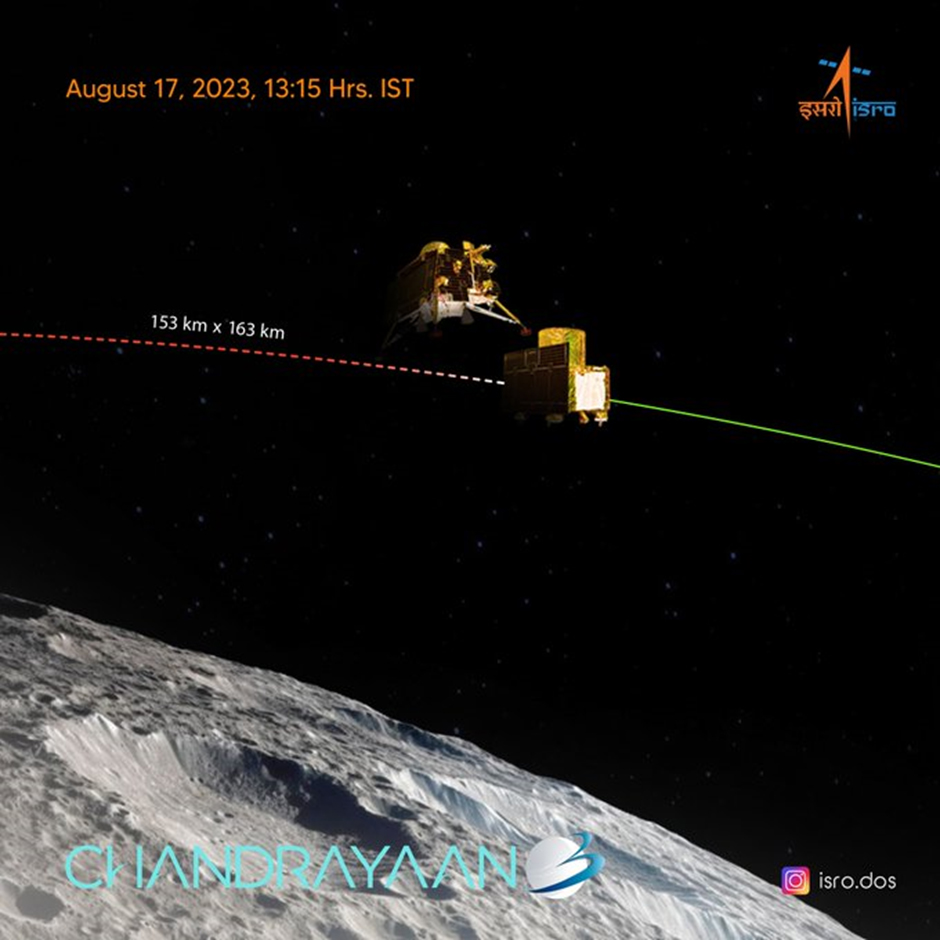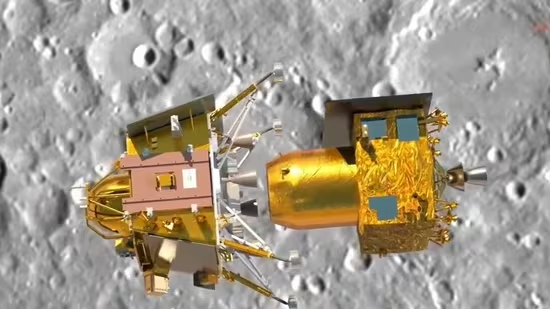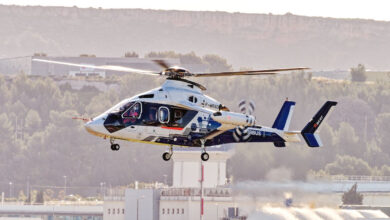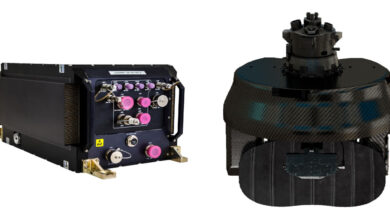Vikram Lander successfully separated from propulsion module, says ISRO
Chandrayaan 3 Updates:
- ISRO shares update on Vikram Lander separation
- Lander Module successfully separated from Propulsion Module, deboosting planned for August 18, 2023
Bangalore, August 17. Marking a significant milestone in India’s third lunar mission, the Indian Space Research Organisation (ISRO) on Thursday successfully separated the Vikram lander from the propulsion module of the Chandrayaan-3 mission at around 1:15 pm.

India’s Chandrayaan-3 spacecraft is set for a scheduled moon landing on August 23, aiming to become the fourth nation to achieve this milestone.
The Indian Space Research Organisation (ISRO) is embarking to achieve a successful soft landing on the Moon with the launch of Chandrayaan-3.
The spacecraft is now primed for its scheduled moon landing on August 23. This endeavour places India on track to become the fourth nation globally to achieve this remarkable milestone, joining the company of the United States, Russia, and China.
The mission was launched effectively on July 14 via the GSLV Mark 3 (LVM 3) heavy-lift launch vehicle from the Satish Dhawan Space Centre in Andhra Pradesh’s Sriharikota.
It is poised to touch down on the moon’s exterior on August 23. It represents India’s third lunar expedition and its second endeavour to achieve a delicate landing on the Moon’s terrain.
The Propulsion Module will continue its journey in the current orbit for months or years, said ISRO.
“The SHAPE (Spectro-polarimetry of Habitable Planet Earth) payload onboard the Propulsion Module would perform spectroscopic study of the Earth’s atmosphere and measure the variations in polarization from the clouds on Earth – to accumulate signatures of Exoplanets that would qualify for our habitability!” ISRO said, adding that this payload is shaped by its U R Rao Satellite Centre in Bengaluru.
ISRO Chairman S. Somanath had recently said the most critical part of the landing is the process of bringing the velocity of the lander from 30 km height to the final landing, and that the ability to transfer the spacecraft from horizontal to vertical direction is the “trick we have to play” at that moment.

A look at orbit reduction maneuvers carried by Chandrayaan-3
Post its launch on July 14, Chandrayaan-3 entered into the lunar orbit on August 5, following which orbit reduction maneuvers were carried out on the satellite on August 6, 9, 14 and 16, ahead of separation of both its modules today, in the run-up to the landing on August 23.
Landing Module deboosting planned for August 18
Landing Module is set to descend to a slightly lower orbit upon a deboosting planned for tomorrow, i.e, August 18 around 1600 Hrs., IST , says ISRO
Meaning of the name ‘Vikram’ and ‘Pragyan’
Developed by ISRO, Chandrayaan-3 includes a lander module named Vikram, which means “valour” in Sanskrit, and a rover named Pragyan, Sanskrit for “wisdom”.
The landing phase of the spacecraft will commence next
After separating from the propulsion module, the landing phase of the spacecraft will commence, where the space agency will perform a series of complex braking manoeuvres to facilitate a soft landing.
Performing spectroscopic study of the Earth’s atmosphere
Instruments onboard will “perform spectroscopic study of the Earth’s atmosphere and measure the variations in polarisation from the clouds on Earth — to accumulate signatures of Exoplanets that would qualify for our habitability!”
Chandrayaan-3: Objectives of India’s moon mission
The objectives of Chandrayaan-3, India’s third lunar mission, are safe and soft landing, rover roving on the moon’s surface, and in-situ scientific experiments.
Chandrayaan-3 Mission: Next step of Lander Module
In the next step Lander Module will descend to a slightly lower orbit around the Moon on Friday.
Chandrayaan-3: What next in India’s moon mission?
Now, the Vikram lander will embark on the final phase of the Moon mission without a propulsion module. The next Lander Module move will take place on August 18.
What will happen to propulsion?
Lander Module of Chandrayaan-3 spacecraft comprising the lander and rover has successfully separated from the Propulsion Module today.
Next, the Lander Module will descend to a slightly lower orbit around the Moon on Friday. The propulsion module will continue its journey in the current orbit for months or years.
ISRO informed that the Lander Module (LM) said, ‘Thanks for the ride, mate’ after it successfully separated from the Propulsion Module (PM).
The Chandrayaan-3 mission’s lander is named after Vikram Sarabhai (1919–1971), who is widely regarded as the father of the Indian space programme.
Chandrayaan-3: Role of Pragyan Rover
Pragyan Rover: This robotic vehicle’s name means ‘wisdom’. The six-wheeled vehicle has instruments configured with payloads to provide data related to the Moon’s surface. It will gather data on the elemental composition of the atmosphere.
The manoeuvres will eventually put Vikram in an orbit where the Perilune (closest point to the Moon) is 30 km and Apolune (farthest point from Moon) is 100 km. The final landing of Chandrayaan-3 will be attempted from this orbit.
Chandrayaan-3: Role of Vikram lander
Vikram Lander: ISRO has named the lander after Dr Vikram A Sarabhai, the father of the Indian Space Programme. According to the ISRO, the Vikram lander consists of three payloads for its objectives. RAMBHA-LP – which will measure the near-surface plasma (ions and electrons) density and its changes with time; ChaSTE or ‘Chandra’s Surface Thermophysical Experiment’ – which will carry out the measurements of thermal properties of the lunar surface near the polar region; and ILSA or ‘Instrument for Lunar Seismic Activity’ meant to measure seismicity around the landing site.
What is Moon’s south pole region?
It essentially contains ice and may be rich in other resources. The South Pole’s frozen water may date back billions of years and has been untainted by the Sun’s radiation or the geological processes, according to NASA.
The craters are cold trapped that contain a fossil record of hydrogen, water ice, and other volatiles dating from the early Solar System. The matter trapped in the southern lunar region wouldn’t have witnessed much change over the years and could thereby hold clues to early life.
Scientists have always been fascinated by the southern lunar pole.
India’s Chandrayaan-3 and Russia’s Luna-25: race to Moon’s south pole heats up
The race to the uncharted south pole of the Moon is quickening with India’s Chandrayaan-3 and Russia’s Luna-25 gearing up for lunar landings next week, each mission holding significant implications beyond the thrilling competition in the skies.
Chandrayaan-3: Mistakes ISRO wants to avoid
ISRO has expanded the landing area and has chosen a spot with a 4km x 2.4 km area, instead of a 500 square metre.
The ISRO scientists have added more fuel to the lander this time.
Changes have been with the lander’s design. The lander has no thrusters and will operate on four thrusters only. Its legs have also been made stronger to absorb the impact of landing.
Chandrayaan 3: Lander module separation took place between 1 pm to 1.30 pm.
Have other countries made a successful soft landing on the Moon?
The successful landing of Chandrayaan 3 will make India the fourth country in the world to achieve the feat. However, no other country has ever touched down on the lunar South Pole.
Know more about the components and objectives of Chandrayaan-3
Chandrayaan-3 components include various electronic and mechanical subsystems intended to ensure a safe and soft landing such as navigation sensors, propulsion systems, guidance and control among others.
Additionally, there are mechanisms for the release of rover, two-way communication-related antennas and other onboard electronics.
The stated objectives of Chandrayaan-3 are safe and soft landing, rover roving on the moon’s surface, and in-situ scientific experiments.
What is the cost of Chandrayaan-3 mission?
The approved cost of Chandrayaan-3 is ₹250 crores (excluding launch vehicle cost). Reports however peg the launch services cost at around ₹365 crore.
Achievements Chandrayaan 1 and 2 achieve?
The key scientific outcomes from Chandrayaan-2 include the first-ever global map for lunar sodium, enhancing knowledge on crater size distribution, unambiguous detection of lunar surface water ice with IIRS instrument and more. The mission has been featured in almost 50 publications.
During the Chandrayaan-1 mission, the satellite made more than 3400 orbits around the moon and the mission was concluded when the communication with the spacecraft was lost on August 29, 2009, according to the Indian Space Research Organisation (ISRO).
India’s Chandrayaan-3 Mission different from Russia’s Luna-25, says ISRO scientist
An Indian space scientist has said that Mission Chandrayaan-3 is vastly different from Russia’s Luna-25 in terms of methodology, route, and experiments.
ISRO Chairman S Somanath on Chandrayaan-3 mission
Chairman of the Indian Space Research Organisation (ISRO), S Somanath last week expressed confidence in the progress of the forthcoming lunar mission, Chandrayaan 3, providing reassurance that all systems are operating as planned.
Chairman S Somanath stated, “Everything is going fine now. There will be a series of manoeuvres until it lands (on the Moon) on 23rd August. The satellite is healthy.”
Chandrayaan-3 – ISRO’s follow up attempt
Chandrayaan-3 is the ISRO’s follow-up attempt after the Chandrayaan-2 mission which faced challenges during its soft landing on the lunar surface in 2019.
The Key goals of Chandrayaan-3 Mission
Chandrayaan-3 is primarily focused on achieving three key goals: a secure and gentle moon landing, enabling the rover to traverse the lunar terrain, and conducting scientific experiments in situ.
All you need to know about Chandrayaan-3
Chandrayaan-3, the third mission in India’s lunar exploration series, began its journey on July 14 this year and successfully entered lunar orbit on August 5. It is meticulously adjusting its orbit in preparation for a soft landing attempt within 40 days of launch.
Chandrayaan 3: ISRO’s lunar mission inches closer to landing; What lies ahead in upcoming week
Chandrayaan-3 vs Russia’s Luna-25 race to the moon: here’s who will claim the south pole position 1st
Russia launched its first lunar landing spacecraft after 47 years on 11 August. This mission comes as the landing date for India’s Chandrayaan-3 approaches. The timeline of their landing on the Moon’s surface could match or could even narrowly beat Chandrayaan-3.
India’s ambitious Chandrayaan-3 mission hit another mark on Wednesday when its spacecraft successfully underwent a fifth and final lunar-bound orbit manoeuvre, which brings it even closer to the surface of the Moon.
ISRO has revealed two images obtained from the Chandrayaan-3 spacecraft. The first image offers a view of Earth, taken by the Lander Imager Camera. The second image shows the Moon, it was taken by the Lander Horizontal Velocity Camera onboard on August 6.
(Images courtesy: ISRO)





